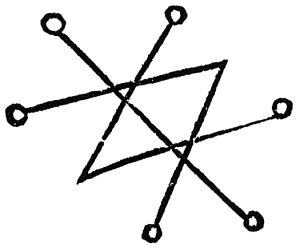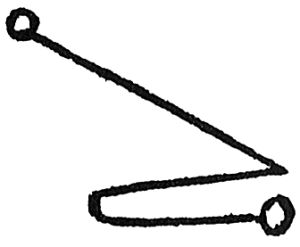Azazel

Areas of influence: metal smithing, cosmetics, geology, finery, removal of sins (in the aspect of the scapegoat) and possibly inner strength (in terms of his name meaning “God Strengthens”). Removal of sins can also be seen symbolically as removal of things no longer wanted such as bad habits. Give them to the scapegoat and send it off into the wilderness.
Symbols: goats, weapons, shields, banners, finery of all sorts. If we look at the image in Dictionnaire Infernal, we also find him holding a trident and the banner has an image of a toad or frog on it.
Colours: Red (Fire), Blue (said to be a Prince), Black (Saturn), but also Purple and Orange have been noted.
Offerings: Anything to do with metal smithing, so smithing equipment, hammer, tongs, etc. Cosmetics and make up, beautify yourself for Azazel. Cinnamon and green tea.
Element: fire
Direction: place of midsummer or the Fire Element in your Compass. Commonly north in the southern hemisphere, south in the northern hemisphere.
Planet: Luna/Moon or Saturn
Incense: Frankincense, Myrrh, Eucalyptus, Rosemary, Patchouli, Sandalwood
Enn: Eya on ca Azazel aken
Regarding the Azazel sigil
The sigil commonly used to represent Azazel is in fact the Seal of Saturn (this symbol). The Spirit of Saturn, which is this symbol, has the name Zazel. This is where things got confused, the names being so similar. Although it appears that the person who may have originally publicly made this mistake was Maxine Dietrich who ran with it and never bothered to correct her idiotic claims.


Frater V.I.M. states in an old blog post (since removed back in 2020 by the looks of it), “As far as I can tell, the first time the Seal of Saturn was promoted as an ‘Azazel Sigil’ was by Maxine Dietrich (neo-Nazi, Alien-cultist) on her website ‘Joy of Satan’ over 10 years ago [now more than 15 years ago]. There, she supplied the Seal of Saturn along with an entertaining story about how Azazel had personally stopped by and given her that ‘sigil.’”
So, which sigil do you use? Three options really. First, use the Seal of Saturn. Enough people have used it as the sigil of Azazel and have been none the wiser, and gotten results. This does beg the question of how important and effective the sigils and seals of the spirits actually are. I would say they are simply a focus point in order to connect with the spirit, but not necessarily defining the spirit.
Secondly, use one of the other sigils that have been given to various people. Same as above really.
Thirdly, ask Azazel for a sigil that is personal to you. In that regard you can also ask him for a name to be used when you wish to call on him which is personal to you.
The Origins of Azazel
The name Azazel finds its roots in ancient Hebrew scriptures, particularly in the context of the Day of Atonement (Yom Kippur) described in the Book of Leviticus. In Leviticus 16:7-10, the high priest would indeed prepare two goats as part of the sin offering ritual. The first goat was chosen for a sacrificial offering to atone for the sins of the people, while the second goat was designed as Azazel, the “scapegoat” upon which the high priest would symbolically transfer the sins of the community, sending the goat into the wilderness to carry away the burden of transgressions. The etymology of the name itself is uncertain, with interpretations ranging from “scapegoat” to “mighty one against God.”
Biblical Interpretations
In biblical traditions, Azazel is often viewed as a rebellious and fallen angel or a demonic figure. The Book of Enoch, an ancient Jewish text not included in the canonical Bible, expands on the narrative, depicting Azazel as one of the leaders of the Watchers—angelic beings who descended to Earth and cohabitated with human women, resulting in the birth of hybrid entities known as the Nephilim. Azazel, in this context, is portrayed as a teacher of forbidden knowledge, introducing humanity to arts, sciences, and the secrets of magic.
As Se’irim
There is speculation that Azazel falls into the category of the Se’irim from Hebrew mythology, however there is no definitive translation of this word. It is said to mean “he-goat” but also “hairy one” which tends to refer largely to satyrs, the Pan-like figures from Greek mythology. Because Azazel was the scapegoat, taking the sins into the wilderness, the connection with the goat has been made, however there is still much debate about this. It is quite possible that with Azazel’s connections to the he-goat and the wilderness, he is in fact a Se’ir. I tend to lean in the direction of him being such.
Azazel in Occultism
In occultism, Azazel emerges as a complex and multifaceted figure, embodying a synthesis of both celestial and chthonic qualities. Occult traditions, spanning a wide array of esoteric practices and beliefs, have woven intricate narratives around Azazel, elevating him to the status of a mystical guide, an initiator into hidden truths, and a custodian of arcane knowledge.
1. The Occult Grimoires:
Azazel is frequently referenced in various occult grimoires, which are books containing instructions for ceremonial magic, rituals, and invocations. Within these texts, practitioners often invoke Azazel for guidance, wisdom, and assistance in their magical endeavors. Some grimoires depict Azazel as a mediator between the divine and the earthly, facilitating the practitioner’s connection to higher realms.
2. The Keeper of Forbidden Knowledge:
One of the central themes surrounding Azazel in occultism is his association with forbidden knowledge. Esoteric traditions suggest that Azazel bestowed upon humanity the secrets of alchemy, astrology, and other occult sciences. In this context, Azazel is viewed as a benevolent figure, offering seekers access to profound insights that transcend the limitations of conventional understanding. Initiates are encouraged to explore the boundaries of consciousness and reality, guided by Azazel’s esoteric teachings.
3. The Symbolism of Rebellion:
Azazel’s rebellious nature, as portrayed in occult lore, is often framed as a rejection of conventional religious dogma and societal norms. Occultists interpret this rebellion as a call to question established truths, break free from mental constraints, and forge one’s spiritual path. The symbolism of Azazel aligns with the broader occult ethos of individual empowerment, self-discovery, and the pursuit of personal enlightenment outside the confines of mainstream beliefs.
4. Alchemy and Transformation:
In alchemical traditions, Azazel is sometimes associated with the transformative process of spiritual evolution. The alchemical journey, akin to Azazel’s fall and subsequent redemption in some interpretations, represents the cycle of death and rebirth, dissolution and coagulation. Azazel becomes a symbol of the alchemist’s inner journey, guiding them through the stages of purification and transmutation toward spiritual illumination.
5. Modern Occult Practices:
In contemporary occult practices, Azazel continues to hold relevance. Some modern occultists invoke Azazel in rituals aimed at personal transformation, seeking insight into the mysteries of the self and the universe. Others view Azazel as a guardian spirit or a mentor in the exploration of magical arts. The archetype of Azazel persists in various magical traditions, reflecting the enduring appeal of this enigmatic figure.
Some Traditional Crafters will also work with Azazel, although their relationship becomes somewhat personal and will differ from one practitioner to the next. Some might see Azazel as a guide to the liminal spaces, representing the transformative journey into the unknown or the hidden aspects of the self. In this regard there is often an association made between Azazel and Tubal Cain, who is sometimes seen as a symbolic figure representing craftsmanship, metalworking, and the forging of tools. The association with metalworking suggests a connection to transformation and mastery of one’s craft. Some regard Tubal Cain as having been the avatar of Azazel.
The Watcher
Azael, also known as Azazel, and sometimes Semyaza, plays a significant role in certain non-canonical texts, particularly in the Book of Enoch, which is part of the broader collection of Jewish apocalyptic literature. The Book of Enoch, attributed to the patriarch Enoch, provides narratives that expand upon the brief mention of the Watchers in the canonical Book of Genesis.
1. The Watchers and Their Descent:
- According to the Book of Enoch, a group of angels known as the Watchers descended to Earth with the purpose of aiding humanity. However, they soon deviated from their divine mission.
- Azael is often listed as one of the leaders among the Watchers who transgressed, engaging in forbidden activities and violating the natural order established by God.
2. Azael’s Role in Human Interaction:
- Azael is specifically highlighted for introducing forbidden knowledge and practices to humanity. This includes teaching humans various arts and sciences such as metallurgy, cosmetics, and the secrets of magic.
- The imparting of this forbidden knowledge is seen as a transgression against the divine plan, as it leads to corruption and moral decay among human societies.
3. Cohabitation with Humans:
- One of the most controversial aspects of the narrative involves the Watchers, including Azael, taking human wives and fathering children with them. This union between celestial beings and mortals results in the birth of a group of hybrid beings known as the Nephilim.
4. Divine Judgment and Punishment:
- God, upon witnessing the corruption and wickedness brought about by the actions of the Watchers, including Azael, decides to intervene. Divine judgment is pronounced, and the Watchers are condemned for their transgressions.
- Azael, in particular, is often singled out for severe punishment. Different versions of the narrative describe Azael being bound or cast into a desolate place as a consequence of his actions.
5. Legacy in Apocalyptic Literature:
- The story of Azael and the Watchers has left a lasting impact on apocalyptic and mystical traditions. It reflects themes of forbidden knowledge, divine punishment, and the consequences of supernatural beings interfering with human affairs.
- These narratives contribute to a broader understanding of the complexities of good and evil, the consequences of rebellion against divine order, and the challenges faced by humanity in the cosmic struggle between celestial forces.
As the chief Angel of the Watchers, or Grigori, some will also use the name Semyaza. Some will use both names interchangeably; some will define them as separate entities. Azazel also has a connection to Paimon and a variety of other Daemons.
This can be said to be the aspect of many faces or masks. They can be worked with as independent entities, but make up a whole as it were.